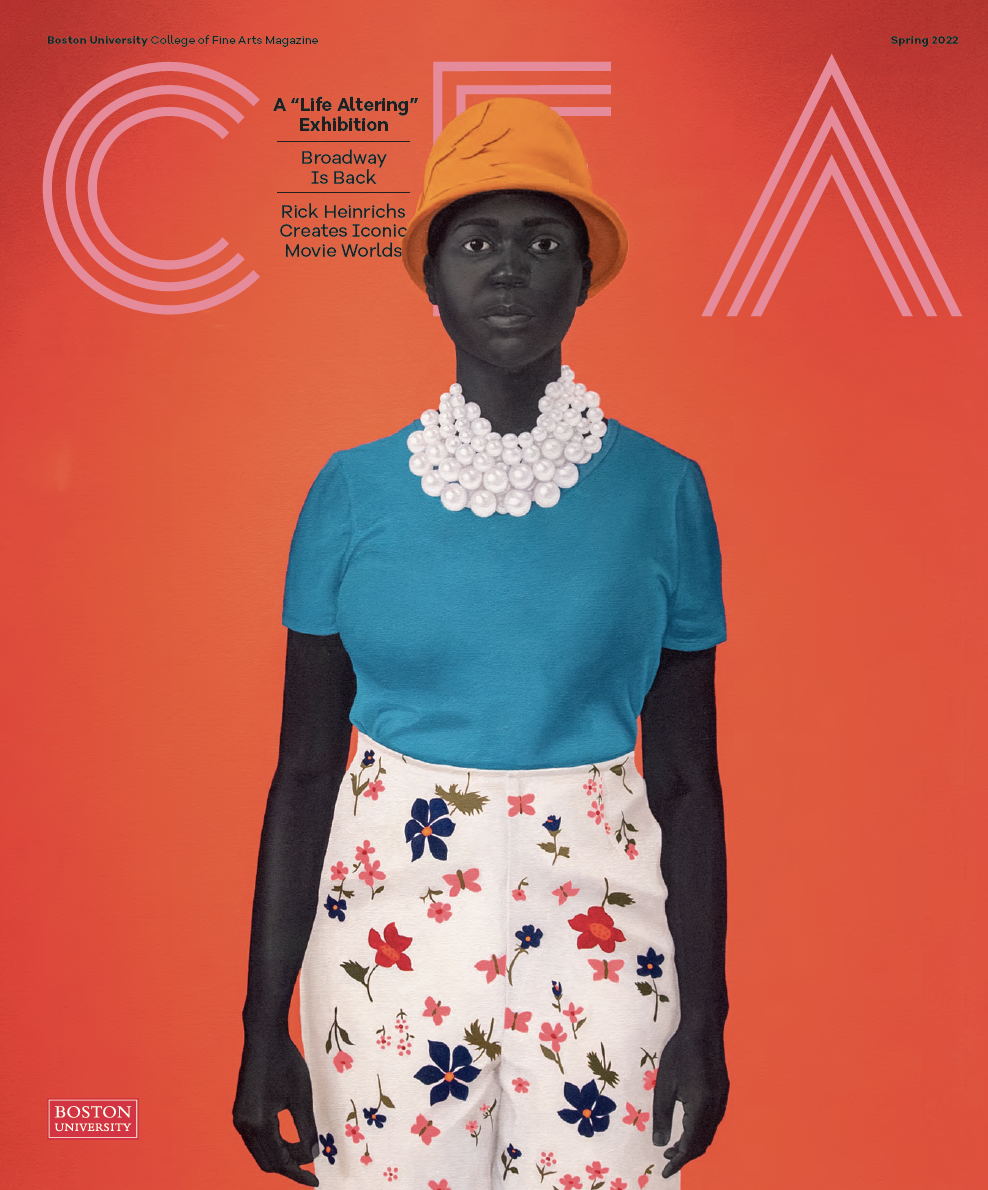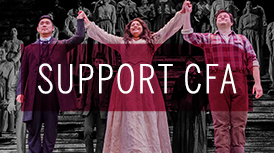Broadway is Back
As casts and crews return to the stage, many productions want to flip the scripts—to right systemic wrongs
By Mara Sassoon | Photo by Alexi Rosenfeld/Getty Images
Walk around Manhattan’s Theater District these days and it may seem as though nothing has changed since the pandemic forced Broadway to go dark for 18 months beginning in March 2020. In the afternoon, a line of people hoping to snag discount tickets to a show snakes around the TKTS booth and its iconic red steps in the heart of Times Square. That evening, a throng of eager theatergoers waits to be let into the Bernard B. Jacobs Theatre to see the Tony Award–winning singer and actor Patti Lupone in the revival of Company.
But look a little closer, and it’s clear that things have changed. Many people in the TKTS line wear masks. While they no longer check for proof of vaccination or a negative COVID test as of May 2022, theater personnel at the doors of the Jacobs continue to remind everyone in line that they must wear their masks throughout the entire performance.
Still, inside the Jacobs—or any of Broadway’s 41 historic theaters during those magical minutes before the lights dim and the production starts—audience excitement is palpable. A group of friends huddles together in their seats, giddily clutching their playbills and smiling behind their masks for a quick selfie. Others take in the intricate details of the theater. More than once someone says, “I’ve missed this.”
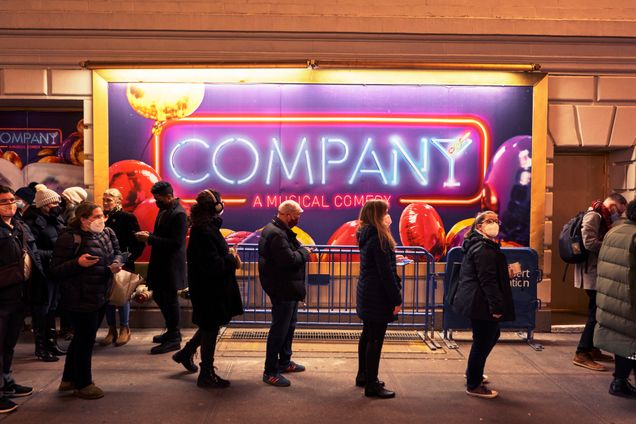
People line up outside the Bernard B. Jacobs Theatre for a performance of Company in January 2022. Until May 2022, theatergoers had to show proof of vaccination or a negative COVID test to see a Broadway production. An Rong Xu/The New York Times
Yes, things are a little different, but Broadway is back after its longest break ever. A typical season might include 30 to 40 plays and musicals—both originals and revivals—that employ almost 100,000 people locally. The 2018–2019 season brought in almost $1.83 billion and was the highest grossing season in Broadway history, according to The Broadway League.
Since September 2021, more than 30 productions have opened or reopened, including Company, Funny Girl, and The Music Man. The musical Mrs. Doubtfire, which had only a few days of Broadway previews before the shutdown, resumed previews in October 2021 and officially opened two months later, although it faced a couple of COVID-related hiatuses and an early closure.
“Jeez Louise, was it emotional. We’re performers, so we’re inclined to be perhaps a little more dramatic. But I was unprepared for the swell of emotion being up there together again.”
“It’s been a wild ride,” says Brad Oscar, who played Frank Hillard, the brother of Daniel Hillard (aka Mrs. Doubtfire), in the musical. Oscar (’86), a Tony Award–nominated actor who starred as Nostradamus in the original Broadway production of Something Rotten!, spoke with CFA in December 2021, at the tail end of Mrs. Doubtfire’s first four-day hiatus following multiple positive COVID tests in the company. “It’s frustrating because we’re playing a game of stop and start,” he says. “But even through these hiccups, we are back and we’re going to get through this.”
Despite the hardships that Mrs. Doubtfire and other shows have experienced, many have characterized the pandemic-induced pause Broadway went through as a much-needed opportunity to reconsider its systemic issues, including pay parity and diversity, equity, and inclusion. In November 2021, the New York Times reported that some plays and musicals, including The Book of Mormon, The Lion King, and Hamilton, “are making script and staging changes to reflect concerns that intensified after last year’s huge wave of protests against racism and police misconduct.”
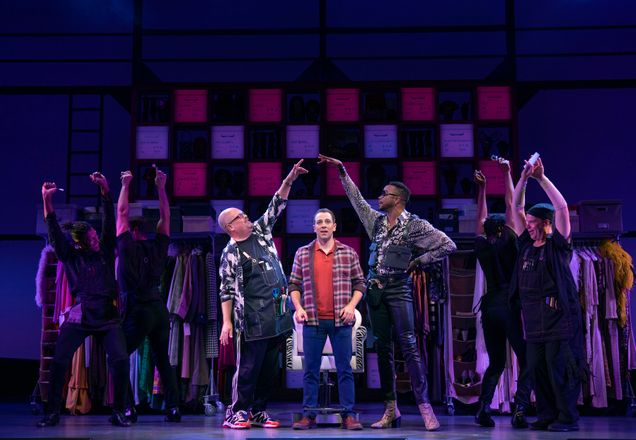
Tony Award–nominated actor Brad Oscar (’86), at left, played Frank Hillard in Mrs. Doubtfire. Sara Krulwich/The New York Times
“I think it’s time the theater and film industries get with the program and realize that there are all sorts of truly brilliant actors out there who can play any role,” says Tony-winning producer Fred Zollo (CAS’75), who coproduced the Broadway revival of Macbeth, starring Daniel Craig and Ruth Negga. The production, which premiered in March 2022, is notable for its inclusive creative team and casting, including actor Amber Gray (’04) in the traditionally male role of Banquo, and the nonbinary actor Asia Kate Dillon as Malcolm. “It’s taken us a very long time—way too long,” says Zollo, “but we are finally starting to see productions taking this view.”
“It’s Gonna Be All Right”
A few weeks before Mrs. Doubtfire reopened on Broadway in December 2021, the cast appeared on Good Morning America to sing one of the show’s playful songs, “Bam! You’re Rockin’ Now.” At the end of their performance, they segued into a peppy riff on the musical’s closing number, “As Long as There Is Love.” Their words rang like a resilient battle cry: “It’s gonna be all right—as long as there is love.”
The show finally had its opening night on Broadway on December 5, 2021.
“Jeez Louise, was it emotional,” Oscar says. “We’re performers, so I think we’re inclined to be perhaps a little more dramatic. I knew I missed performing because this is such a part of who I am—it feeds my soul. But I was unprepared for the swell of emotion being up there together again.”
Watch Brad Oscar and the cast of Mrs. Doubtfire perform on Good Morning America in November 2021. Video courtesy of Independent Musicians Foundation
After it returned to Broadway, Mrs. Doubtfire followed intense COVID protocols, including working with an outside company to manage its staff testing program, and having two compliance officers at the theater each day to ensure theater staff and audiences adhered to masking, testing, and vaccination requirements. Oscar says he went to the theater every day to get tested.
Even so, not long after its short December hiatus, as Omicron cases rose, Mrs. Doubtfire’s creative team made the difficult decision to pause the show temporarily, from January 10 until April 14, 2022, promising to rehire everyone who wanted to return after that time. Lead producer Kevin McCollum told the New York Times that shutting down the production for that period would ultimately save it from running out of money. The Times reported that the show’s expenses ran close to $700,000 per week, regardless of whether performances took place. “My job is to protect the jobs long-term of those who are working on Mrs. Doubtfire, and this is the best way I can do that today,” McCollum told the Times. But by mid-May, he announced the show would have to close at the end of the month—three months early—because sales hadn’t improved enough. The musical still has plans for a month of performances in the UK in fall 2022 and a US tour beginning in late 2023.
Coming Back, Moving Forward
While Broadway shows are still contending with how to handle pandemic-related disruptions, they are also examining how to grapple with some long-standing problems. “We acknowledged that, yes we’re back, but let’s just not come back to where we were, let’s move forward,” says Oscar.
“The fact that we’re opening the door to writers, actors, and artists from everywhere—it only enriches the theater.”
Even before the pandemic and the racial reckoning of 2020, the lack of diversity, equity, and inclusion was a primary concern for many in the theater industry. The labor union Actors’ Equity has published a series of reports on these topics since 2017. In 2020, they released a diversity and inclusion report that looked at the demographics of its members from 2016 through 2019. In an opening letter to the report, Actors’ Equity executive director Mary McColl noted that while there had been some progress, such as more contracts being given nationally to women and people of color, “these gains have been woefully insufficient, and not uniformly true across the country.” The report found that of the total Equity contracts nationally—including principal, chorus, stage manager, and assistant stage manager contracts—63.95 percent were given to people who identify as white. “Among production contracts,” the report said, “much of the increased representation of people of color can be attributed to multiple productions of Hamilton alone.” The report also called out that “barely” one percent of contracts were given to members with disabilities.
“I think we’ve always been aware of the issues of representation in theater,” says Oscar, “but it continues to happen. And you think, ‘How does this continue to happen?’ I’m hopeful that something just broke—in a good way—and we make real change. It broke because it’s been breaking for, well, centuries.” He says Mrs. Doubtfire’s creative team made sure that the cast and crew attend a series of diversity trainings before diving into rehearsals.
Casting director Tara Rubin says that representation is at the center of every project she works on now. “It’s the first conversation we have, and it’s no longer a goal—it’s just a given,” says Rubin (CAS’77). “We didn’t do a good enough job in the past.”
Improving representation onstage begins with those who are doing the casting—a field distinctly lacking in diversity, says Rubin. “But I’d say there is an industry-wide consideration and movement toward improving that,” she says. The professional organization Casting Society of America launched a training and education program for young people who are interested in the field, with the goal of helping BIPOC students jump-start their careers. Rubin says that she and her colleagues also participate in a mentorship program with the goal of helping underrepresented groups break into the casting world. “We’re really training our eyes on how we can improve our own industry and create a viable pipeline for people.”
Oscar is upbeat about the changes he’s seen. In the two years prior to the pandemic, he performed in three regional plays that featured “the most diverse group of actors that I’ve ever worked with. I’m a white, middle-aged, Jewish gay man, but in all three of those productions, I was a minority. And I thought, ‘Isn’t that cool?’”
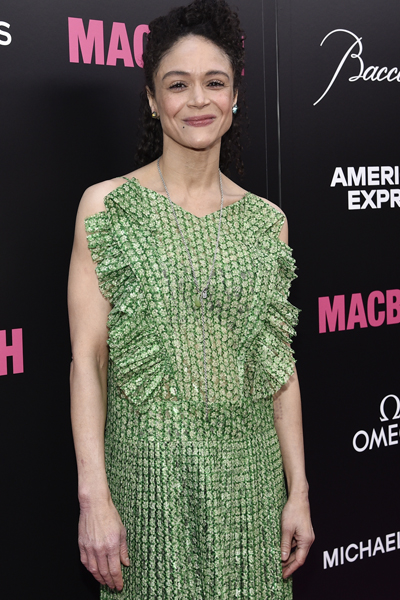
The Broadway revival of Macbeth is notable for its inclusive casting, including actor Amber Gray (’04), in the traditionally male role of Banquo. Greg Allen/Invision/AP
Harvey Young, dean of the College of Fine Arts, also says he’s observed “a sea change in artistic leadership [in regional theater], with more women and people of color appointed as executive or artistic directors.”
“The lineup of plays, playwrights, and productions [in regional theater] has never been more representative of the US,” says Young, a nationally recognized theater educator and a member of the College of Fellows of the American Theatre. “The single ‘diversity slot’—for a woman and/or person of color playwright—in a season has multiplied.
“What hasn’t changed, or has been slow to change, is the makeup of theater audiences,” says Young. “There is still more outreach needed to make theater accessible and affordable to more people.”
Some strides in improving accessibility of productions have been made, including presenting shows in new, experimental formats. Young points to the success of Ratatouille: The TikTok Musical and the Pulitzer Prize nomination for the online play Circle Jerk as signs that people are beginning to embrace alternate ways to attend and experience theater. Jeremy O. Harris, who wrote Slave Play, helped produce livestreamed productions of both plays.
Zollo, the producer of Macbeth, has made it a goal to improve the accessibility of his productions. The show had a Macbeth 2022 program designed to provide at least 2,022 tickets to students, with the goal of reaching students who are underrepresented on Broadway, including from BIPOC communities and those with disabilities. “We want[ed] everyone who want[ed] to see this production to have the opportunity to do so,” Zollo says.
Rubin hopes the industry continues to improve on another pressing issue: pay parity. “I would like to make sure that even though we’ve come back—and we’re all very proud of that, and it’s been incredibly hectic—that we don’t take our eyes off the big prize,” she says. “It’s time to really look at some of our financial models and pay structures for all of the departments in creating a theater production.”
Actors’ Equity, in a 2020 hiring bias report that it published in 2022, looked at the industry’s pay statistics in the three months before the pandemic shutdowns and found that “men still earn more than women on average across nearly every job category, and non-binary members tend to earn less than men or women.”
Though there is still a long way to go, Zollo, who has produced more than 100 plays and won seven Tonys in his 40-year career, says the initiatives that are being taken lately have given him hope for better inclusivity across all aspects of productions. “The fact that we’re opening the door to writers, actors, and artists from everywhere—it only enriches the theater.”


